#Welding Materials Market
Explore tagged Tumblr posts
Note
Here's a bit of an odd (but hopefully not unwelcome) question: you've mentioned a couple of times your interest in interior decorating, but how do you *find* items for your house to fit a specific aesthetic? Where do you even look/how do you search for stuff? Or do you just look through shops and flea markets and hope to get lucky?
Ok, I love this question. (You may regret asking if you see the length of this reply 😅)
SO.
The simple answer is, I thrift a lot (on- and offline), I buy at estate sales and auctions, I rarely pass an interior design store without taking a look inside (even stores that are decidedly not my style at first sight), I read industry magazines, I save up for pieces by indie creators, and in some cases I make my own stuff (I can weld and upholster). So yeah, to an extent it's "luck".
The complicated answer is that it's about understanding my own aesthetic and optimising my search experience.
I know a lot of people who sort of know what they like, but also don't really know what they like. They'll be able to look at pictures of interiors and say "I like that" and "I hate that" but not really know how to articulate why. They might even have a label for the aesthetic they prefer, like "minimalist" or "clean and modern" or "cozy Scandinavian" or something like that, but still not really be able to articulate what that materially entails. (Yes, I know, I'm singling out a certain type of people here -I'll stop eyeing them once they stop doing this shit.)
Why is one room "good" to you and another not, even if they're both technically the same style? What makes a space work? What is the "invisible background" in the spaces you love -tall ceilings, exposed beams, greenery outside, natural light, latticed windows, crown moulding? A lot of times people think they like the interior but they really just like the house it's in, much like how you might think an outfit is stylish only because the person wearing it is hot.
Similarly… do you actually love the look of an interior or do you just love the lifestyle implied in it? Do you actually like empty surfaces or are you just tired of cleaning up your housemates' clutter? Do you love big open kitchen/dining room combos or do you just wish you had a social circle that did dinner parties? Do you really want a giant white couch or do you just dream of living in California? Similarly to ads that may be advertising a car but are selling you on the dream of freedom to travel, interiors are tied up with non-material desires and aspirations. And while that's not *bad* per se, it's very difficult to actively work towards an aesthetic if you can't tell apart that aesthetic from the underlying desires. After all, you want an interior that works for the space you actually have and the life you actually live.
The reason this is important is because the moment you understand what you are really after, you are no longer bound by names of designers, shops and styles. It stops mattering. You can find things you enjoy anywhere, from thrift shops to IKEA to antiques auctions to specialty warehouses to Etsy, without it needing to be tagged with the label of an aesthetic you're trying to fit in. A lot of the "but how will I even find anything"/"everything I love is too expensive" stress disappears like this.
Understanding how your preferred style and aesthetic actually works under the hood also gives you insight into what sort of things you *need* to make it work, what stuff adds depth and volume but can't carry the theme by itself, and what sort of things are "false friends" -stuff that seems like it "should" fit your aesthetic but actually hampers it in the space you're in. (As in: a big white sectional is not gonna give you California Cool in a cramped terrace house in Birmingham, rather the opposite.)
The second-best advice in interior designing is "buy what you love" -the genuinely best advice is "understand what you love". Because once you do, you'll find things you like everywhere.
There's also optimizing your search. This is one of the few things where website algorithms are actually your biggest friend. One of my favourite things is the "more like this" function on a lot of platforms. If you tidily keep and organize favourites on Etsy, the algorithm will typically present you with stuff that's genuinely similar to items you already like. Just using Instagram to follow artists and creators you like will curate your feed and expose you to other stuff that fits the look. Pinterest allows you to both passively and actively find similar looking items, which can expose you to items and designers you never knew existed.
Favouriting items on my most-used second hand platform (2dehands, a local Belgian thrifting platform) will actively put items that visually resemble those favourites on my front page. It's awesome, and you can "weaponize" it in your search.
For example, earlier this year I really wanted an Asian style lacquer cupboard. They can be quite expensive, and usually get picked up fast second hand. So for a week or two, I actively searched for and favourited *every* lacquer cupboard I found on 2dehands, including ones I didn't like, that had the wrong dimensions, or that were far too expensive for me. Fairly quickly, my front page was essentially all lacquer cupboards, including ones that weren't even advertised as such and that I would never have found through the textual search function. And lo and behold, I found the perfect one, and it was an absolute steal too.
Another way to optimise your search is to cast a wide net. I never pass a home décor store or antiques warehouse without taking a peak. I have bought items when I was on work trips, when I was visiting family, when I was on holiday. "Thrift stores near me" is my favourite search on google maps. And yes, sometimes that meant carrying a mahogany prayer chair on my back while walking 30 minutes to the train station in high heels and office clothes xD
A final tip is to sometimes just trust your gut and go for it. A couple of my favourite buys are ridiculous shit, like a chair shaped like high heel and a bronze statue of a robot giving cunnilingus to a woman. And the biggest interior design regrets I have are all items I didn't buy. (to this day I regularly think about the giant 5-panel hand-painted Chinese screen doors I passed up on and the Lucite dining chairs I couldn’t arrange transport for.) There is such a thing as "too cohesive" in interiors. Your home is not a catalog photo; sometimes, particularly if the item is unusual or unique, you gotta trust your affection for it without necessarily knowing how it fits in the picture. (In a way, your brain is also an algorithm subject to customisation through exposure. Learn to trust it! ^^)
It's important to note with all of this though… this is my hobby. I love spending time on it. I imagine if you're trying to curate an interior this way when you're new to it (especially if you're trying to get to a certain look all at once without any mistakes or misbuys) it's hella overwhelming and time-consuming. It's not for everyone. But even if you have no interest in turning your home decor into a hobby, the base principles still apply. If you understand what you're really after, it's much easier to identify things that would work in your space, anywhere you go, no matter how often you actually go looking.
(My own house is very much NOT perfect -a perpetual “blessed mess and work in progress”, in all honesty. But well. I AM out here giving advice, so feel free to check out some non-staged, very much non-magazine worthy pics of my home, below the cut.)




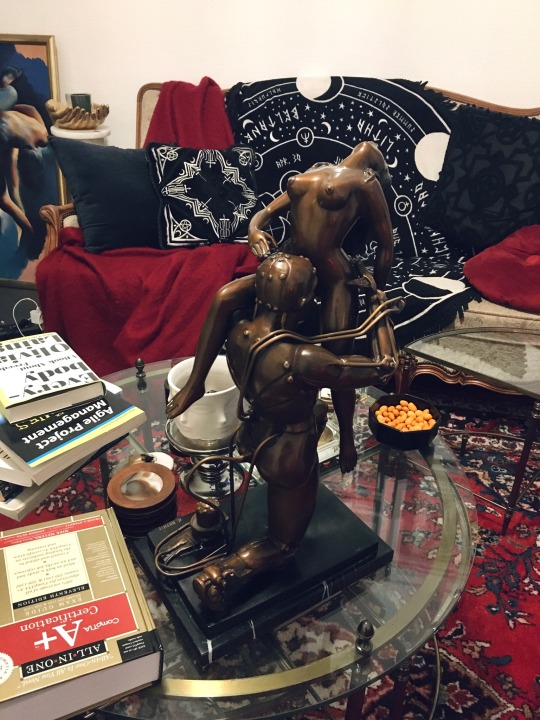
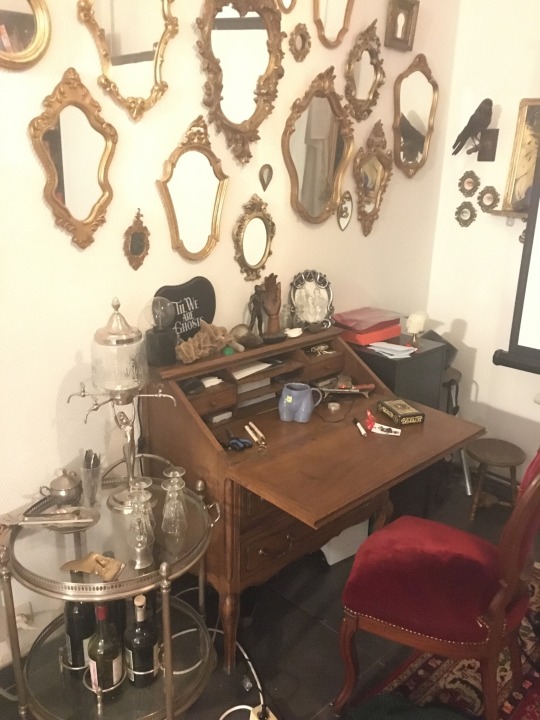
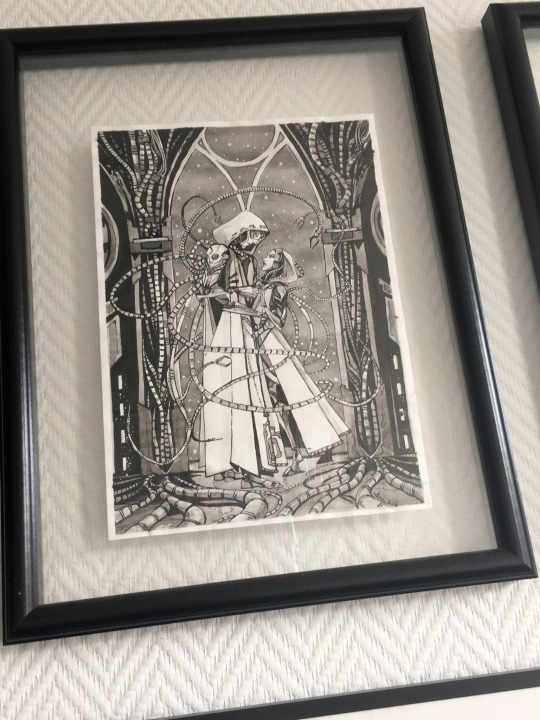
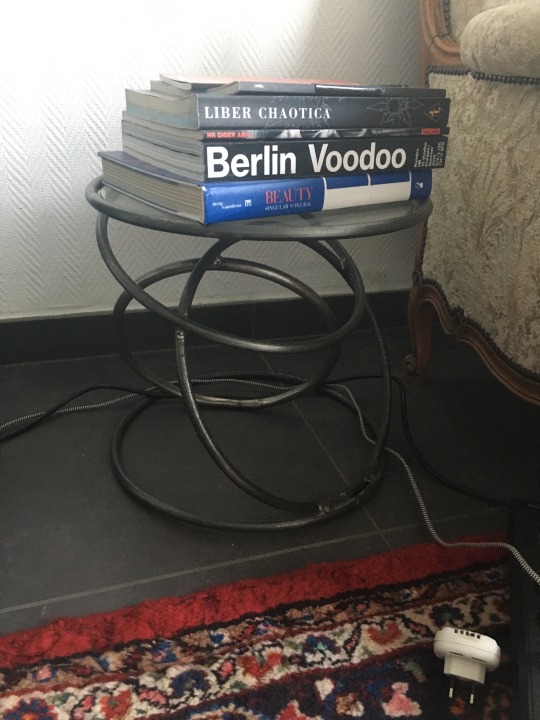
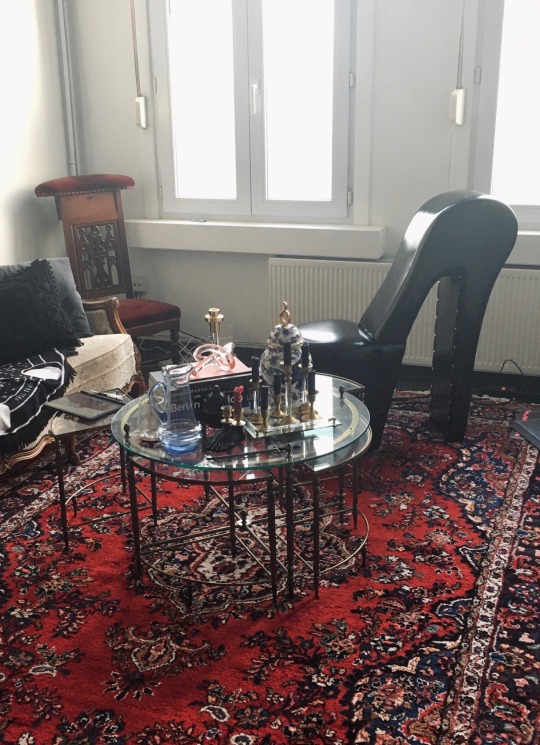
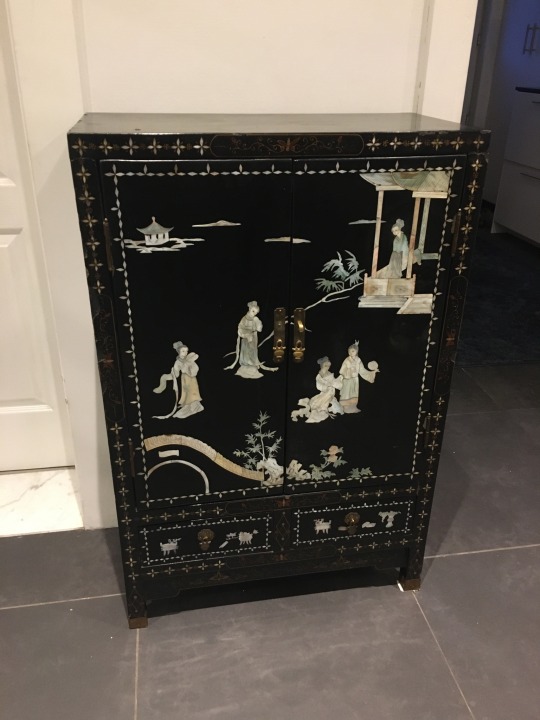
#disaster replies#disaster house#interior design#interiors#maximalism#interior design inspiration#home decor
9 notes
·
View notes
Note
Evening. Does welding one of Harrison’s apocalypse rails to a Lancaster void the warranty? One of my soldiers won’t shut up about it, saying it’s like a “pre-fall technical”, whatever that means.
I don’t actually care if it’s safe to shoot mind you, that idiot got involved with some Horus cell a few years back and now the base printer will spit him out every time he dies, even when we unplug it.
Good evening!
While it will not void the warranty, as we do encourage end users to customize their IPS-Northstar mechanized chassis to their heart’s content, we do not recommend attaching the Apocalypse Rail to a Lancaster. While the Lancaster can be modified for superheavy weaponry mounting (at the cost of other weapon mounts and some degree of safety shielding), the Apocalypse Rail is designed to feed directly from reactor power in a way that can start cascades in unprepared systems. While the Lancaster will be fine at the end of the day, we do worry for the safety of the pilot and weapon that could be cooked off in a rather unpleasant way.
If you’re looking for a safer alternative that still packs the punch you’re looking for, consider swapping the Rail for the IPS-N/HA Tachyon Lance. This joint venture product is the most accurate and destructive exotic-material energy weapon on the market—target effect occurs before you even pull the trigger.
That being said, we encourage you to try it if, as you mentioned, there is no risk of pilot injury. Let us know how it goes!
30 notes
·
View notes
Text
MS ERW Butt Weld Reducer Concentric-India Supplier
An MS ERW Butt Weld Concentric Reducer is an important pipe fitting used to connect two pipes of different diameters while maintaining the centerline alignment. These reducers are widely used in industries like oil & gas, chemical processing, water treatment, and power generation. The concentric design ensures smooth fluid flow, making them suitable for vertical and fluid transport pipelines. The use of Electric Resistance Welding (ERW) in these reducers guarantees strong, durable, and seamless joints.
Key Features of MS ERW Butt Weld Concentric Reducers
Material: Constructed from mild steel (MS), which offers excellent strength and durability.
ERW (Electric Resistance Welded): ERW welding provides a strong, uniform weld that enhances the overall durability and integrity of the reducer.
Butt Weld Connection: Ensures a seamless, leak-proof, and permanent joint between pipes, making it highly reliable for industrial applications.
Concentric Design: Aligns the centerlines of the pipes, making it ideal for vertical pipelines and for applications where maintaining uniform flow is essential.
Benefits of Using MS ERW Butt Weld Concentric Reducers
Durability: The mild steel construction ensures long-lasting performance, even in challenging industrial environments.
Leak-Proof Joints: Butt weld connections provide strong, leak-free joints that prevent any leakage, ensuring safe and efficient operation.
Efficient Fluid Flow: The concentric design reduces the risk of turbulence, ensuring smooth and uninterrupted fluid flow in the pipeline.
Cost-Effective: MS ERW butt weld concentric reducers offer a cost-effective solution for connecting pipes of varying diameters without sacrificing performance or durability.
Finding a Reliable Supplier of MS ERW Butt Weld Concentric Reducers in India
When searching for a reliable supplier for MS ERW Butt Weld Concentric Reducers in India, consider the following factors:
Quality Assurance: Ensure that the supplier provides reducers that meet industry standards and are manufactured using high-grade materials.
Competitive Pricing: Look for suppliers that offer the best balance of price and quality.
Timely Delivery: Reliable and prompt delivery is key to avoiding project delays.
Customer Support: Opt for suppliers who offer comprehensive customer service and after-sales support.
Udhhyog – Your Trusted Supplier for MS ERW Butt Weld Concentric Reducers
At Udhhyog, we are dedicated to providing high-quality MS ERW Butt Weld Concentric Reducers at competitive prices across India. Our expertise in industrial steel products and our commitment to customer satisfaction make us the go-to supplier for businesses in need of reliable and durable piping solutions.
High-Quality Products: Our reducers are manufactured using top-grade mild steel and precision welding processes to ensure durability and long-term reliability.
Affordable Pricing: We offer some of the most competitive prices in the market without compromising on product quality.
Reliable Delivery: Udhhyog ensures prompt and efficient delivery to meet your project timelines.
Exceptional Customer Service: Our team is always ready to assist with any inquiries or after-sales support, ensuring a smooth purchasing experience.
To buy MS ERW Butt Weld Concentric Reducers and explore other industrial fittings, visit Udhhyog's website and browse our wide selection of industrial products at affordable prices.
#MSErwReducer#ButtWeldFittings#ConcentricReducer#IndustrialFittings#Udhhyog#IndiaSuppliers#PipeFittings
2 notes
·
View notes
Photo
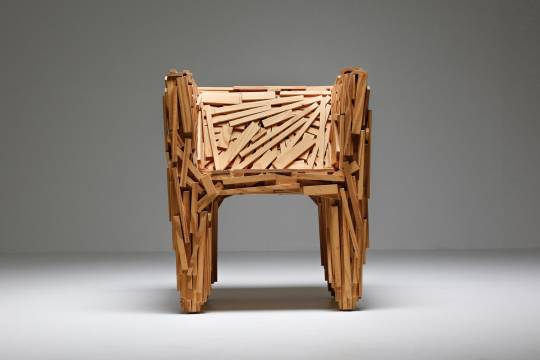


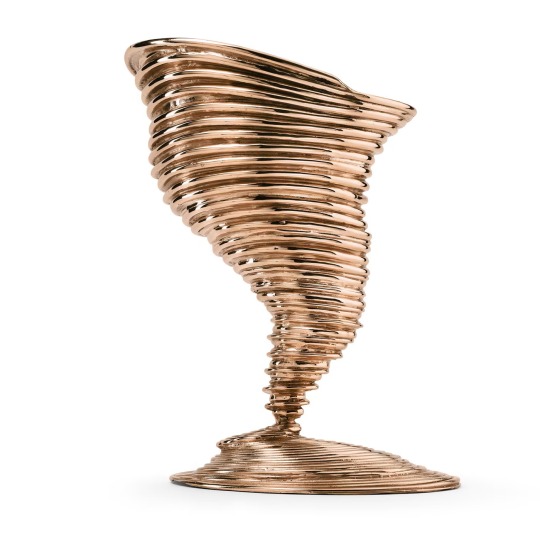






Fernando Campana (1961 – 2022)
Born in the rural town of Brotas, the São Paolo-based designer earned a degree in architecture from the Faculdade de Belas Artes de São Paolo in 1984, before creating Estudio Campana that same year with his older brother Humberto, an attorney.
During the 1980s the studio produced a series of sculptural metal chairs welded from iron called Desconfortáveis (Uncomfortables), eventually moving toward a practice using everyday materials like cardboard, rope, wicker, bamboo, and wood. Their iconic Favela Chair, from 1991 was fabricated with scraps of wood from discarded fruit crates, nailed and glued by hand. “The people who live in favelas construct their own homes, so I thought, why not construct a chair myself,” said Fernando in a discussion about the seat with curator Darrin Alfred from a 2010 interview. It was, he explained at the time, meant to symbolize a Brazilian shantytown.
It was in the 1990s—a time when the design world was primarily focused on the post-World War II movement of the Italians—that the Campanas came on the scene, with work that underscored Brazilian culture and its craft, sculpting furnishings from a range of raw and found materials. Their 1993 Vermelha Chair was a lesson in resourcefulness, hand-woven from cotton rope that enveloped a metal frame.
Design journalist Arlene Hirst was “gobsmacked” when she first encountered the chair, manufactured by Italian manufacturer Edra, at the Salone del Mobile in Milan. A year later the chair was included in Project 66: Campana Brothers/Ingo Maurer, a 1998 exhibition at The Museum of Modern Art (MoMA), curated by Paola Antonelli, the museum’s senior curator of architecture and design, an associate at the time. For this show, Antonelli paired the Brazilian brothers’ furniture with German lighting designer Ingo Maurer’s luminaires in vignettes that highlighted a shared passion for materiality and invention.
Both Fernando and Humberto were active in the production process as well, but as is often the case with partners, they remained elusive about specific roles. “Fernando had the training, so he was the more pragmatic one,” noted Antonelli in a recent interview, referring to his architectural roots. “He never discussed it. And I never questioned it. It was implied,” she said. The younger Campana also drew inspiration from his daily routines, local markets and wandering São Paolo’s streets. Antonelli recalled asking him about his use of found objects, asking if they weren’t too cute? His response, “They are not too cute. They are part of my life.”
Many of those found objects—including stuffed animals—made their way onto upholstered seating like the 2002 Banquete series, which became the equivalent of a sold-out Broadway show. It is still produced out of the Campana São Paolo studio, and handsewn by local craftspeople who are considered part of the extended Campana family.
In 2010 the New York- and L.A.-based gallery Friedman Benda began global representation of the brother’s work. “Campana Studio brought a completely fresh perspective, creating a dialogue with local crafts and the use of the readymade,” says co-founder Marc Benda, adding, “They were trailblazers.” The gallery assisted with support of the studio and helped them to balance the commercial success of their practice with its roots in the hand made.
One of the brothers’ last collaborations—presented in June at the 2022 Salone in Milan—is a collection called Metamorfosi, comprising five large-scale, pouf seats and a tapestry, created in collaboration with Italian textile designer Paola Lenti. Woven from remnants Lenti sorted and saved with CouLture Migrante, a social tailoring atelier (involving men and women asylum seekers residing in Como, Italy) the limited-edition pieces make their North American debut at Design Miami in December.
The work of Estudio Campana can be found at the Vitra Design Museum, Centre Pompidou, Musée Des Arts Décoratifs, MoMA, among other design-focused institutions. In 2020, they were the subject of 35 Revolutions, a retrospective at Museum of Modern Art, Rio de Janeiro on the occasion of their 35th anniversary.
Words by Melissa Feldman
Favela Chair for Edra, 2000, Pine, Height: 29.14 in (74 cm)Width: 26.38 in (67 cm)Depth: 24.41 in (62 cm)Seat Height: 15.75 in (40 cm),
Vermelha Armchair for Edra, 2019, Aluminium, Cord, natural cotton, Steel, 86 x 58 x h.77 cm,
Tornado Vase, Ghidini 1961, Bronze, W 11.81 x D 9.45 x H 14.57,
Jackfruit Table Lamp, Ghidini 1961, Polished Brass, Height: 19.69 in (50 cm), Diameter: 12.21 in (31 cm),
Bomboca Sofa GM, Objets Nomades, Louis Vuitton, 46.9 x 34.5 x 94.9 cm (18.5 x 13.6 x 37.4 in),
Bolotas Sofa (Cherry), 2019, Sheep’s wool, ipÊ, H: 95 W: 125 L: 215, Carpenters Workshop Gallery,
Edward Scissorhands side table, Giustini/Stagetti, 2014, Portorotype black marble and gilded bronze, 12 dia. x 22½ h in. (Casati Gallery),
Corallo Armchair for Edra S.p.A., Italy, 2004, Steel wire and epoxy paint, 38 x 60 x 39" (96.5 x 152.4 x 99.1 cm), Courtesy MoMa,
Sushi Buffet, 2012, Carpet, rubber, EVA, fabric and estela handcrafted into sushi rolls partially covering brass structure 28.25 x 78.75 x 17.75 inches (72 x 200 x 45 cm)
#art#design#furniture#lamp#vase#campana brothers#sofa#buffet#rubber#bronze#tornado#jackfruit#louis vuitton#edra#brazil#icon#legend#rip#bolotas#favela#chair#fernando campana#rip fernando campana
54 notes
·
View notes
Note
From what I've seen online, the major consensus amongst HP fans is that Cursed Child is NOT canon ( and many simply pretend it doesn't exist). I remember when it first came out and was being promoted, both the stage show and the published script, and everyone was really excited for new HP material... until we realised that it just... wasn't canon... at all. Yeah, the idea of Voldemort as presented in the HP novels having any sort of romantic relationship with Bellatrix and having a child is simply ridiculous and certainly just exists as a way for him to have a secret child for reasons of the wacky plot... it's very tween fanfic and also very Disney channel sequel (like the og villains all having kids we never heard about is totally a real Disney channel thing).
I remember it being very clear at the time that it came out that any "pointers" or "ideas" JKR provided to the actual writer of CC must've been the very barest of bones, the tiniest of shards perhaps, because it simply read like a sort of AU fanfiction written by the most casual of fans... which, as I understand, it really was. At the time when it came out, it was pretty clear that she had very little to do with actually writing it, though I suppose more was made later of her 'involvement' to legitimise it. I heard since that someone asked her if it should be considered canon, and she said yes? Not sure how this interaction actually went down as I don't particularly care to look into it (since nothing will change my mind that the AU of CC makes no sense within the context of HP canon and lore and it was probably some kind of marketing tactic in support of the stage play) but as she clearly didn't actually write CC herself and it contradicts many things from the books she did write, I'm pretty happy to continue ignoring its existence.
What do you think of Fantastic Beasts in comparison? Personally, I put Fantastic Beasts in a separate category where I can kind of accept aspects of it as canon expansions of the lore and worldbuilding... I can see JKR's style clearly and the inconsistencies with timelines and certain characters being in places and times they shouldn't be don't bother me as much as the straight up character assassination we see in CC. To put it another way, I think CC feels like it belongs to a totally different IP and was written by a different author (because it was) while FB definitely still exists in Rowling's wizarding world, it's just the timeline is kinda off.
this is interesting context. I think she kind of has to say yes to that question in context, because like... who's going to shill out £150 to see some random dude's AU fanfiction play (if it isn't even good)? of course, JKR's stamp isn't nothing, but even she can't weld extra content into the canon by declaring it so. i see TCC like church ephemera: i'm sure SOMEONE finds it interesting or relevant to what we're doing here, but that doesn't mean it's part of the Bible.
i feel the same way about fantastic beasts, but to a lesser extent. i actually enjoyed the first fantastic beasts movie, i thought it was playful and charming and (with the exception of the dumb polyjuice plot) the perfect way to revive harry potter as a storytelling vehicle. like, yeah, it fucked up by trying to go too big too soon, but if you can remove one (1) subplot or narrative thread and have a solid movie, then as a writer, you've still done okay.
Fantastic Beasts also annoys me because it does feel like harry potter, in terms of tone and mouthfeel. it's got the sauce. it just heinously drops the ball in later installations. in particular, it starts getting nervous about holding the audience's attention and throws stuff in that just wouldn't make it in a natural, organic script — most of the shit from the original series is contrived and ill-suited to the dramatic tenor set by Movie About Funny Man Collecting Magical Animals. (e.g. going back to hogwarts? leta lestrange's secret white father revengeplot triple-rugpull? human nagini?? secret undead dumbledore brother raised by american evangelicals???). i like the idea of it very much. i'm honestly drawn to it as a creative space, because unlike TCC, there is potential there. it's just badly abused.
#as soon as they involved grindlewald#it all became horrendous. there is no world in which the harry potter universe#of “goblin bankers” fame#is intellectually morally or technically equipped to deal with the conversation that ensues when you invoke the fucking holocaust
12 notes
·
View notes
Text

THE BASICS
Name: Samar Persaud.
Nicknames: Sammy, Sam.
Gender: cis Male, He/Him.
Occupation: Sanitation Worker (Garbage Man), Junk Builder.
Age: Thirty-Two.
Birthday: December 15th, 1992.
Zodiac Sign: Sagittarius.
Location: Bighorn Hills, Providence Peak, Colorado.
Birthplace: Providence Peak, Colorado.
Orientation: Bisexual, Biromantic.
THE PHYSIQUE
Eye Color: Brown.
Natural Hair Color: Black.
Height: 6′ 0″.
Body Type: Muscular.
Allergies: None.
Dominant Hand: Right.
Tattoos: Probably some kind of dumb tattoo for @ingridlczano (still pending tho).
Piercings: None.
THE INTRODUCTION
Samar Persaud was lucky early in life; born to two loving parents in a single family home in a quiet neighborhood, with a tall tree overlooking their backyard where he spent hot summer evenings pretending to be a rock climber or a knight or an astronaut, feeling free to go as far as his dreams would take him, forever supported by his family. That luck, however, was short-lived when his dad found himself without a job when Sammy was just five years old. Suddenly, the tree that had held his dreams when he couldn’t carry them all turned into his reprieve from a household, spending every moment he could sitting up in its branches so he wouldn't have to be at home, a home broken by a system that had been a set up from the very start. Hours that passed by in the day soon became something he counted with the number of beer cans stacked up in the kitchen, able to spell michelob before he could even spell his own name. His mom attempted to pick the family back up with a part-time job, but it wasn’t enough to stop the once loving home from falling into disrepair, both emotionally and physically. When Samar was old enough, he learned how to use a hammer and a drill and fixed the things his father was too drunk to fix. His fixes weren't perfect and often cobbled together by other things he found laying around, materials he got for free after putting in some work under the table for local hardware stores, and items he found on the side of the road on trash day. Growing up with Ingrid Lozano was enough to keep his sanity. She was his safe place to land when his home grew too much to handle, she was the rock that never budged in his life, the stability he craved from a family that would never be able to give that to him again. They found exactly what they needed in each other, a semblance of a home they never had. Their friendship eventually bled into more and inevitably, they found themselves bouncing from on to off and back again over most arguments that never really meant a thing when it came down to it, yet both were too stubborn to knock it off. They knew a fight never meant forever though, their comfort in one another running far too deep to call their friendship quits. With her support and unsolicited opinions, he eventually purchased a few acres of land in Bighorn Hills with a house that needed more fixes than his childhood home did and a barn that was empty and full of promise, eventually something he filled with the treasures he would find on the side of the street, sitting out for free, during his early morning garbage shifts. He'd take anything he could find home, storing it until he found the right pieces to fit together, and creating something new out of it. He taught himself how to built, weld, and put together the tiniest, most confusing parts of virtually any machine. On Saturdays in the summer, he can be found at the farmer's market with a stall proudly displaying these secondhand pieces he managed to give a new life to.
THE HEADCANONS
Sam has one cat, a giant orange tabby named Poppy, who enjoys roaming his acres of land, will typically live inside during the winter, and will come and go through an open window in the summer. She enjoys lounging in the barn in her cat bed that he made for her while he's working on new furniture pieces. Unsure of what to do with acres of land and having no intention of becoming a farmer (yet), Samar planted a boatload of flowers across an acre and allows whoever to come pick their own flowers, offering a u-pick option or prepicked bouquets in a little stand near the entrance to the field. The only rule is to leave flowers for others and don't harm the bees that may be around the flowers. He still drives a messy, beaten up pick up truck from the early 2000s that used to be his dad's before the man became too far gone to drive it. He repairs it when it needs to be repaired, but it's generally been trusty for most of his life. This man collects vintage Coleman camping items like his life depends on it. Anytime he sees some on the side of the street, it's the holy grail for him. Sam cleans it up, restores whatever is necessary, and it gets to continue to live on during his camping trips. He plays the banjo. 100% serious. He found one on the side of street once with a bunch of free stuff, repaired and refurbished it, and now it's a gorgeous instrument that he plays around campfires and whenever someone asks to hear it (or doesn't, he's a unsolicited banjo player sorry in advance).
3 notes
·
View notes
Photo
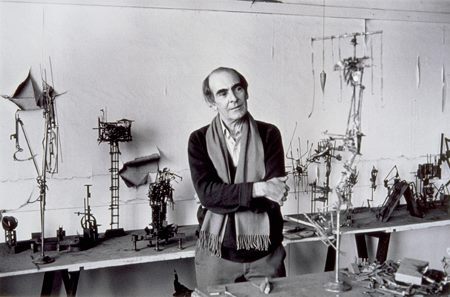
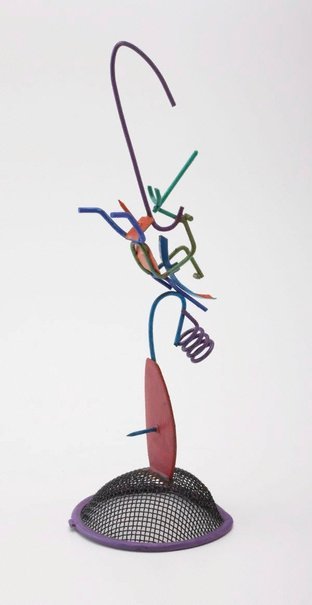
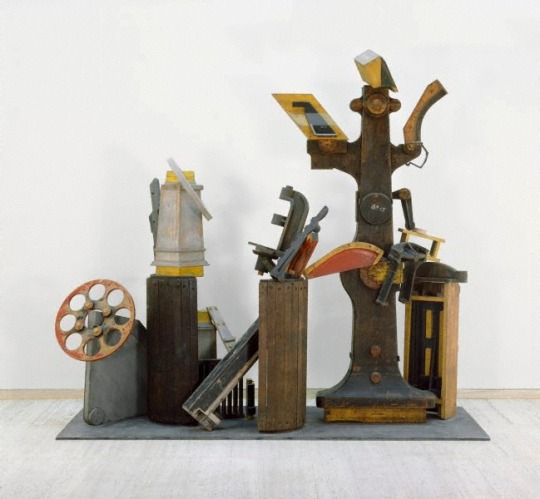

Klippel with assemblages in his studio
Number 1060, (1995) painted wire, tin 22.5 x 7.6 x 7cm
Number 714 - Prototype for Adelaide Plaza (1988) Construction of brazed and welded steel, geometric sections, found objects, formed sheet metal. 69.5 x 64 x 49.5 cm without base
Number 329, (1977) assemblage of collected wood parts 300 x 350 x 135cm
search @www.artgallery.nsw.gov.au
A Klippel's practice exeplifies the interconnectedness of the conceptual and the material. His bodies of work explore the relationship between the organic and the mechanical.
B By the time Robert Klippel died in Sydney in 2001, aged 81, he was critically acclaimed and well collected in his home country. But as with most Australian artists, although he had lived for stints in Europe and the US from the 1940s until the 1960s, his work was largely unknown abroad.
Eleven years on, his son has secured a blue chip shot at changing that. Klippel junior has signed Galerie Gmurzynska in Zurich as the sole representative of his father’s estate worldwide, catapulting the artist into the company of Pablo Picasso, Yves Klein, Alexander Rodchenko and David Smith, whose estates the gallery also represents.
Some of Klippel’s large wooden sculptures have already been on the Gmurzynska stand at Art Basel, Art Basel Miami and ArtHK, and a substantial publication and exhibition is being planned for the coming year.
Klippel is the only Australian artist to have been taken on by the 50-year-old gallery, which is best known for introducing the Russian avant garde to western Europe and for representing modernist artists working up to 1980.
“We have a solid reputation for scientific research, and for promoting interesting, important historic figures who have created something authentic but who have not had the exposure they should have had,” says gallery co-owner Mathias Rastorfer.
Klippel, an abstract artist and loner not easily slotted into one particular movement, was loosely influenced by surrealism, cubism and constructivism.
According to Deborah Edwards in the 2002 Art Gallery of NSW retrospective catalogue, “his attitudes to art making were grounded in European modernism and postwar intellectual thought”. It is for this reason, in part, that Gmurzynska was interested in taking him on.
Rastorfer says: “We found him very interesting due to his connection to the constructivists, his Polish origins, his time in America. The more you go into Klippel, the more modernist links you find.
“We will introduce his work in the context of those peers, taking him out of the Australian context and putting him into an international one. We want to show where he fits in worldwide.”
Klippel’s bronze sculptures have been the most collectable in Australia. They appear regularly on the secondary market and can fetch more than $100,000. The top price paid at auction – $507,800 – was in 2006 for a miniature steel, tin, acrylic paint and coloured paper collage.
Gmurzynska plans to use the large, wooden sculptures and tiny coloured plastic ones that Klippel did in the late 1980s and early 1990s to introduce him internationally. This is in part for practical reasons, because this is most of what is left in the estate, but also because he thinks these will work best there.
Rastorfer expects to take at least three years to achieve traction internationally for Klippel. “One of the biggest temptations is to sell the four or five most important works straight away, because that’s the easiest thing to do,” he says. “But then the estate is left with the lesser known work and often doesn’t know what to do with it.
“It’s about placement in museum collections, in significant private collections, and with opinion makers, not just about selling. If we show him in the context of his better- known peers, the rest will follow.”
There are no guarantees the strategy will work, but Andrew Klippel is quietly excited that his father, to whom he was very close, is getting a posthumous chance at an international career.
After years in the music business, where things happen very quickly, his foray into the visual arts is teaching him a new virtue: patience. “This is a long play.”
Katrina Strickland http://www.afr.com (2012)
2 notes
·
View notes
Text
Copper Nickel 70/30 Sheets And Plates Exporters in UAE
Meraki Star Metals Oil & Gas Equipment Trading L.L.C. industry has sorted out some way to acquire a recognizable market in collecting, conveying and giving broad assortment of Copper Nickel 70/30 Sheets and Plates. We give the client an obliging method for managing satisfy the requirements of our clients to satisfy their necessities.
Copper Nickel 70/30 Sheets and plates are made using premium quality copper. These sheets and plates come in various shapes, sizes, length and thickness. Further, they can similarly be framed by the prerequisites and solicitations of the clients. They come in different designs like rolls, circles, foils, ring (flange), penetrated sheets, checkered plates, shim sheets and plain sheets. They have different lengths like twofold erratic, single sporadic and cut length. They furthermore shift in finishing as a couple of sheets and plates have hot moved finishing, some have cold rotted finishing, etc. They in similar manner come in different hardness types like sensitive, hard, half hard, quarter hard, spring hard, etc.
The sheets are used in condensers, power plants, and seawater directing and exchanger shells. The plates are used in versatile metal hose, weld wire, pot parts and welding backing rings. These sheets and plates are furthermore used in various endeavors like substance organizations, drugs, power industry, sugar production lines, crush and paper industry, and substantial industry.
Due to their high disintegration impediment, incredible versatility and flexibility, the Copper Nickel 70/30 Sheets and Plates are significantly famous. These sheets and plates moreover have properties like adversaries of damaging, high warm and electrical conductivity. They, moreover, have extraordinary mechanical and appealing properties. The sheets are unyielding in nature and besides have plausibility.
They have extraordinary solidness, astounding surface culmination, and harsh turn of events, and can persevere in high temperature locales and in significant weights, heavenly layered precision. The sheets and plates, moreover, have the limit of oxidation.
Before Copper Nickel 70/30 Sheets and Plates are full and conveyed to the clients, they go through various testing cycles to satisfy the quality and rules of the thing. A part of the tests integrates pitting impediment test and hardness test. Huge scope/little test, intergranular utilization test, positive material conspicuous evidence tests, praising test substance and mechanical test.
Cupro Nickel Sheets and Plates Specification : ASTM B151 / ASME SB151 Dimension Standard : JIS, AISI, ASTM, GB, DIN, EN, etc Width : 1000mm, 1219mm, 1500mm, 1800mm, 70 / 300mm, 2500mm, 3000mm, 3500mm, etc Length : 70 / 300mm, 2440mm, 3000mm, 5800mm, 6000mm, etc Thickness : 0.3 mm to 120 mm Form : Coils, Foils, Rolls, Plain Sheet, Shim Sheet, Perforated Sheet, Chequered Plate, Strip, Flats, Blank (Circle), Ring (Flange) etc. Surface Finishing : Hot rolled plate (HR), Cold rolled sheet (CR),2B, 2D, BA, NO.1, NO.4, NO.8, 8K, mirror, Chequered, embossed, hair line, sand blast, Brush, etching, SATIN (Met with Plastic Coated) etc.
For more information : Visit our website : https://www.merakimetals.ae Contact us : +971-523973687, +971-48801107, +971-48240333 Email : [email protected]
#Copper Nickel 70/30 Sheets And Plates Manufacturers in UAE#Copper Nickel 70/30 Sheets And Plates Suppliers in UAE#Copper Nickel 70/30 Sheets And Plates Stcokists in UAE#Copper Nickel 70/30 Sheets And Plates Exporters in UAE
4 notes
·
View notes
Text
Business Operations Plan
My business operations plan for Molten Ironworks is pretty straight forward. I plan on using scrap metal to produce metal art pieces, as well as quick welding repairs needed around you home. My overhead for inventory is next to nothing, and all basic equipment needed is already owned. This equipment includes a welder, welding shield, welding electrodes, clamps, tape measure, grinder and grinding discs, gloves, safety boots, safety glasses, fire resistant clothing, wrenches, rachets, and sockets. Scrap metal collected is usually free, and if new material is needed, I have spoken to an autobody shop about getting any metal needed at cost, ordered through them. The only licenses needed are a business license, and a CWB welding license of which I already possess. Getting the word out around my area for my business might prove a little challenging, because in a small community such as this, social media marketing only goes so far. People trust word of mouth advertising and promotions rather than social media as a trusted source for business. Marketing my art will almost solely depend on social media though, if I am to target a bigger market. Advertising on social media platforms and having a website in the future to feature my art pieces is the plan. I'm basically trying to keep my costs at next to nothing to retain more revenue for the business. This business already sits at a 90% profit margin, so I am strategically using that to my benefit.
2 notes
·
View notes
Note
How about a Striker/Shaker cape who can melt anything she touches? (As long as the material is non-living and capable of melting, so she could do it with ice or metal but not wood or stone). Overall a little bit like Faultline, but with a different method of destruction.
I think this cape having an ability to manipulate the liquid of things she melted would be fun too. If this cape melting her way through your thick metal door wasn’t bad enough, just wait until she pulls a sword out of it!
Limits: large or complex things take a long time and lots of energy to fully melt down, as does any substance with a very high melting point. Just for non-OP reasons, she wouldn’t be able to melt Weld or other Case 53s who happen to be made of meltable material.
See you thought Faultline, I thought Cinereal just because of the cascading effect of the power...If you bring something to melting point and it collapses onto something else then that's on fire as well now.
Trigger event was definitely tied to being trapped somewhere, definitely a jittery nervous wreck with severe claustrophobia and automatically violent reactions when cornered....She is a flightless bird if you know what I'm saying.
The name Meltdown is almost too obvious but I still like it
Costume wise I'm thinking black and charcoal grey, with the absolute minimum of orange and red as a concession to marketing. She's someone who compulsively covers up, a hooded, padded Cape that's built like Panacea's robe but from a material more like a firefighter's uniform. Almost always has her hood up, but at the same time will absolutely not under any circumstances wear the gasmask her costume came with, it's triggering for her.
This is a sad case in the Hero community, someone villains don't even fuck with just out of pity. Didn't want to be a hero, but wanted to help people....Trauma got the better of her and mistakes were made. Submitted herself to the asylum but it made her claustrophobia worse.
The end of Worm was honestly the best thing to happen to her, she can now wander between Earth's Bet and Gimel either alone or with salvage/search and rescue teams; two largely empty worlds mean she's got all the space and solitude she wants and even her worst lapses in control can't hurt people no matter how much damage she does.
Hell, if she can't melt wood then she can literally just set up camp in a forest.
6 notes
·
View notes
Text
Entrepreneurship: Turning Impossibility into Opportunity
The Influenced Disruptor
As early as in the age of four, I already witnessed how my father would cut unused gallons and turn it into a “tabo” a thing we use to scoop water for bathing or even doing the dishes. As time goes by, I am truly amazed that there were materials around us that seems useless, yet with my father’s creative hands he recreates many useful things that we utilized for daily household chores or even decorate some of this. There is this one instance that I have seen him diligently welding numerous irons on a pair of boots, then he attached therewith sharp iron on the toe part of the boots. I am quite confused with the functionality of the thing and asked him, he then explained that the metallic surrounded boots will help him climbed up the trees through piercing the sharp irons on the tree trunks, and ensure his safety while pruning the trees around our house.
In my development stage, I thought of my father’s ideas in innovating and utilizing scrap materials were just because we cannot afford materials or equipment to be used in specific chore. However, on this stage where I have gained enough knowledge about innovation and creativity, I have seen my father’s creations as his way of disrupting order of things given limited resources, even in his simple way to help our daily tasks easier. My aforementioned narrative is not just my way to laud my father but, in this narration, I have drawn the fact that I too can be like him and be a potential entrepreneur. Hence, learning our current subject GEE 16 – Entrepreneurial Mind is way too exciting for me that I could be able to hone up my potentials.
With that in mind, our first discussion in the said subject left me astonished firstly when I have learned to differentiate entrepreneurs from businessmen. Entrepreneurs are those who innovate and seize opportunities amidst the limited resources, while businessmen are the ones who market the product made by the entrepreneurs. In some instances, these two domains are commonly interchanged or misunderstood in different lenses, yet in our discussion it was clearly distinguished and understood. Innovations of these said entrepreneurs were not just to give ease to their own lives but also towards the people around them.
It is undeniably true that with today’s large scale of digitally driven society, living in ease is one of the benefits that entrepreneurs offer us. What struck me most in our discussion is the uprising of Big Tech companies in the recent years holding that much capitalization than they were in the early 2000’s. These companies have built their innovations that is conducive to the current needs of the society even when they start on scrap. Their alteration on the order of things have greatly contributed to the progress of our society, thus, influencing aspiring entrepreneurs like me to strive more in making potentials possible even though with limited resources.
Additionally, I felt the urge to established my choices whether I will be an intrapreneur or be an entrepreneur. Through our discussion, I realized that as an aspiring entrepreneur I need to distinguished between how will a student act and how will an entrepreneur act in some aspects. In our class I must not look dumb but since I’m an aspiring entrepreneur I need to risk being wrong. In connection I must be able to learn the culture of being good enough and not being perfect. Lastly, I should be able to ask help and not act that I know the solution or answer.
Considering all the mentioned narrative above, the introduction of this subject is an eye-opener for me that all through the years I have witnessed innovations and creativity that my father has done. Connectively, those years he has inculcated within me the aspirations to be an entrepreneur, even though I will go through the use of technology but directed towards one goal which is to help in socio-economic development. As I will continue my started journey of entrepreneurship, I am filled with delight that many limitations and hindrances I may face but with persistence and potentials I can make impossibility into opportunity.
2 notes
·
View notes
Text
MS Concentric Reducer-Buy from Delhi Manufacturer
An MS Concentric Reducer is a key fitting in piping systems that allows for a seamless transition between pipes of different diameters, while keeping the centerline aligned. These reducers are commonly used in industries such as oil & gas, water treatment, chemical processing, and construction. Their design ensures an even flow of fluids, making them essential for maintaining system efficiency and preventing turbulence.
Features of MS Concentric Reducers
Material: Constructed from mild steel (MS), these reducers are known for their durability, high tensile strength, and corrosion resistance.
Concentric Design: Ensures the centerlines of the pipes are aligned, which is especially beneficial in vertical piping systems to prevent pressure buildup.
Butt Weld Connection: Offers a strong, leak-proof joint, ensuring the integrity of the piping system.
Versatility: Suitable for various applications, including fluid, gas, and chemical transport in different industries.
Benefits of Using MS Concentric Reducers
Durable Material: The use of mild steel ensures that the reducer is resistant to wear and corrosion, making it suitable for long-term use in harsh industrial environments.
Cost-Effective: MS concentric reducers are an economical choice, providing excellent performance at a lower cost than other materials.
Smooth Flow: The concentric design allows for an even and uninterrupted fluid flow, reducing the risk of turbulence and pressure drops.
Wide Application: These reducers can be used for a variety of fluids and gases, including water, oil, and chemicals, across multiple industries.
Why Buy MS Concentric Reducers from a Delhi Manufacturer?
When purchasing MS Concentric Reducers from a Delhi-based manufacturer, you gain access to several advantages:
Local Availability: Sourcing from a local manufacturer ensures faster delivery times and easier communication.
Competitive Pricing: Manufacturers in Delhi offer competitive pricing due to the region’s industrial base and strong supply chains.
Custom Solutions: A local manufacturer can provide tailored solutions to meet your specific project requirements, including custom sizing or material specifications.
After-Sales Support: With a local supplier, you get the benefit of prompt customer service and post-purchase support, making the procurement process hassle-free.
Udhhyog – Reliable Manufacturer of MS Concentric Reducers in Delhi
Udhhyog is a well-established B2B platform that specializes in the supply of industrial steel products, including MS Concentric Reducers. Here’s why Udhhyog should be your top choice:
Top-Quality Products: We use high-quality mild steel and cutting-edge manufacturing processes to produce reliable and durable concentric reducers.
Competitive Pricing: Udhhyog offers MS concentric reducers at some of the most competitive prices in the market, without compromising on quality.
Fast Delivery: Based in Delhi, we ensure fast and efficient delivery to meet your project deadlines.
Excellent Support: Our dedicated customer service team is always available to address any concerns and provide after-sales assistance.
For more information or to place an order, visit Udhhyog's website and explore our range of MS Concentric Reducers and other industrial fittings.
2 notes
·
View notes
Text
How to Select the Right ERW Pipe for Your Project?
If you're looking for a pipe that can handle high levels of stress and pressure, an electric resistance welded (ERW) pipe may be the best choice for your project. However, with so many options on the market, it can be challenging to know which ERW pipe is the right one for your specific needs. In this article, we'll provide a guide to help you select the right ERW Pipe distributor in Gujarat for your project.

Determine Your Requirements
Before you start looking for an ERW pipe, you need to determine your project's specific requirements. This includes understanding the environment in which the pipe will be used, the temperature and pressure the pipe will be subjected to, the fluid or gas that will be transported through the pipe, and the size and thickness of the pipe needed.
Consider the Material
ERW pipe dealer in Gujarat are made from a variety of materials, including carbon steel, stainless steel, and alloy steel. The material you choose will depend on the requirements of your project. For example, if you need a pipe that can handle high temperatures and corrosive environments, you may want to consider a stainless steel or alloy steel pipe.
Check the Quality
When selecting an ERW pipe, it's essential to consider the quality of the pipe. You should look for a pipe that is manufactured to high-quality standards and has undergone rigorous testing to ensure it can handle the stress and pressure it will be subjected to. Look for pipes that meet ASTM, ASME, and API standards.
Consider the Cost
The cost of an ERW pipe provider in Gujarat will vary depending on the material, size, and thickness of the pipe. It's essential to balance cost with quality and choose a pipe that meets your requirements and is within your budget. However, it's also important not to compromise on quality to save money.
Look for a Reputable Supplier
Finally, when selecting an ERW pipe, it's crucial to choose a reputable supplier. Look for a supplier with a proven track record of providing high-quality pipes and excellent customer service. A reliable supplier should also be able to provide you with technical support and advice to help you select the right ERW pipe for your project.

In conclusion, selecting the right ERW pipe dealer in Gujarat for your project requires careful consideration of your requirements, the material, quality, cost, and supplier. By following these guidelines, you can ensure that you select an ERW pipe that can handle the stress and pressure of your project and provide you with a reliable, long-lasting solution.
#manufacturer#business#distributor#Jindal pipes#steel industry#steel companies#industrial#seamless pipes#piping material#construction structure#construction sites#stainless steel pipes
6 notes
·
View notes
Text
Don’t Overpay-Get the Lowest Prices for SS 304 Flanges Today
When it comes to industrial projects, sourcing quality materials at the best price is crucial. One such essential component is the SS 304 flange, renowned for its strength, corrosion resistance, and versatility. If you're looking to procure SS 304 flanges without breaking the bank, you're in the right place! At Udhhyog, we offer SS 304 flange at the lowest price, ensuring that you can complete your projects efficiently and economically.
What are SS 304 Flanges?
SS 304 flanges are made from stainless steel 304, a widely used material known for its excellent corrosion resistance and high-temperature strength. These flanges are commonly used in various applications, including:
Chemical Processing: Handling corrosive substances without degrading.
Food and Beverage Industry: Ensuring sanitary conditions in food processing.
Pipelines: Connecting pipes in water, gas, and steam systems.
Choosing the right flange is critical to ensuring the integrity and safety of your systems, making it essential to find high-quality options at competitive prices.
Why Buy SS 304 Flanges from Udhhyog?
At Udhhyog, we understand the importance of getting quality products at the lowest prices. Here’s why you should consider purchasing your SS 304 flanges from us:
Unbeatable Pricing: We are committed to providing our customers with the SS 304 flange lowest price in the market. Our efficient supply chain and direct manufacturing processes enable us to offer competitive rates.
Quality Assurance: Quality is our top priority. Our SS 304 flanges undergo rigorous quality checks to ensure they meet the highest standards. You can be confident that you're receiving reliable products that will stand the test of time.
Diverse Selection: We offer a wide range of SS 304 flanges in various sizes and types, making it easy to find exactly what you need for your project. Whether you require slip-on, weld neck, or blind flanges, Udhhyog has you covered.
Quick and Efficient Delivery: We understand that time is of the essence in your projects. Our streamlined logistics process ensures that your order is processed and delivered promptly, minimizing any potential downtime.
Support for MSMEs: Udhhyog is dedicated to supporting micro, small, and medium enterprises (MSMEs) with flexible payment options, including a 45-day credit period. This allows you to manage your cash flow effectively while getting the materials you need.
How to Purchase SS 304 Flanges at Udhhyog
Buying SS 304 flanges from Udhhyog is a straightforward process. Here’s how you can get started:
Visit Our Website: Browse our extensive selection of SS 304 flanges to find the ones that meet your specifications.
Select Your Products: Choose the type and size of the SS 304 flanges you need and add them to your cart.
Checkout Easily: Complete your purchase through our secure checkout process.
Sit Back and Relax: After placing your order, you can relax as we handle the delivery to your designated location.
#SS304Flanges#LowestPrice#Udhhyog#AffordableFlanges#IndustrialSupplies#StainlessSteel#PipingSolutions#QualityFlanges#FlangeManufacturers#BuyFlanges#MSME#FlangeDeals#PipingIndustry#FlangeSupplier#SaveOnFlanges
5 notes
·
View notes
Text
Damascus Steel Has The Most Amazing Qualities!

Damascus steel is a type of steel that is characterized by its distinctive pattern of layering and wavy appearance. It is believed to have originated in the Middle East, specifically in the city of Damascus, Syria, around the 3rd century AD. This steel was highly prized for its strength, durability, and sharpness, and was used to make swords and other weapons.
The process for making this steel is not well understood, as the exact methods used by ancient smiths have been lost to history. However, it is believed that the steel was made by forging together multiple layers of iron and steel, which were then folded and re-forged multiple times. This process created characteristic layering and wavy patterns in the steel. The steel was also treated with acid to further enhance the patterns.
The exact composition of this steel is also a mystery, but it is thought to have been made from a combination of high and low-carbon steels, which gives it its strength and durability. The steel was also known to contain impurities such as vanadium and molybdenum, which may have contributed to its exceptional sharpness.
Today, this steel is still prized for its beauty and durability and is used to make knives, swords, and other high-end decorative items. However, the methods used to make modern steel are not the same as those used in the past, and the steel is not as strong or sharp as true ancient steel.
History of Damascus Steel
Damascus steel is a type of steel that was historically produced in the city of Damascus, Syria, and was known for its distinctive wavy patterns and exceptional strength and sharpness. The steel was produced by a process called pattern welding, in which multiple layers of different types of steel were heated and forged together, creating a unique pattern.
The exact method of how the steel was produced is unknown, as the technique was a closely guarded secret and was lost to history. The steel was highly prized by sword makers and was used to make weapons such as swords, knives, and daggers. The swords were said to be able to cut through other swords and even rock with ease.
This steel was also known for its ability to hold a sharp edge and to be resistant to breaking or bending. Steel was used throughout the Middle East and Europe and was particularly popular during the Middle Ages. The production of this steel declined in the 18th century, and the technique was lost.
Today, modern metallurgists have attempted to recreate the steel using different methods, but the true method of how the original steel was produced remains a mystery. However, knives and swords made of modern steel can be found in the market and they are highly sought after by collectors and enthusiasts.
Qualities of Damascus Steel
Damascus steel is a type of steel that is known for its distinctive pattern and superior strength and durability. The steel is made by layering different types of steel together and then forging them at high temperatures. The layering process creates a unique pattern on the surface of the steel that is often compared to the look of flowing water.
Strength:
One of the key qualities of this steel is its strength. The layering process creates steel that is incredibly strong and difficult to bend or break. This makes it ideal for use in knives and other cutting tools, as well as in other applications where a strong, durable material is needed.
Ability to Hold Sharpness:
Another quality of steel is its ability to hold a sharp edge. The layering process also creates steel that is able to hold a sharp edge for a long time, making it ideal for use in knives and other cutting tools.
Aesthetic Appearance:
In addition to its strength and ability to hold a sharp edge, Damascus steel is also known for its aesthetic qualities. The unique pattern created by the layering process is often highly prized, and many people consider Damascus steel to be a work of art.
Resistant to Corrosion:
Finally, this steel is also highly resistant to corrosion, which makes it a great choice for knives and other tools that will be used in outdoor or damp environments.
Overall, the combination of strength, sharpness, aesthetic appeal, and corrosion resistance make this steel a valuable and sought-after material for knives and other tools.
Various Uses and Purposes:
Damascus steel is a type of steel that was historically used to make swords and knives. It is known for its distinctive pattern, which is created by layering different types of steel and then forging them together. The steel is then repeatedly heated and cooled, folded, and beaten, to create the characteristic pattern.
Steel is also known for its strength and durability. Because of the way it is made, it has a high level of carbon and other impurities that give it a unique set of properties. These impurities also give it a unique appearance, with a distinctive pattern visible on the surface of the steel.
This steel was first made in the city of Damascus, Syria, which is where it gets its name. It was highly prized in ancient times for its strength and beauty and was used to make swords and other weapons for centuries. Today, this steel is still used to make knives and other tools, but it is also used for decorative purposes, such as in jewelry and artwork.
How Popular is Damascus Steel?
Damascus steel is a type of steel that is known for its unique patterning and strength. It was used to make weapons such as swords, knives, and daggers in the Middle East and Central Asia during the medieval period. The steel was made by forging together different types of steel and iron, and the resulting patterning was caused by the layering of the different metals.
This type of steel was highly prized for its strength and durability, as well as its unique patterning. It was said to be able to cut through a rifle barrel or slice a silk scarf in midair. Due to its reputation, weapons made from Damascus steel were highly sought after by warriors and rulers.
However, the technique for making this steel was lost in the 18th century and was never truly rediscovered. Today, modern "Damascus" steel is often made by etching patterns onto blades made from other types of steel. This process creates a similar patterning but does not replicate the strength and durability of true Damascus steel.
Despite this, the popularity and demand for these steel weapons, particularly knives, continue to be high among collectors and enthusiasts of knives and swords.
3 notes
·
View notes